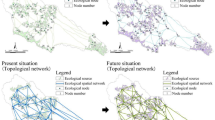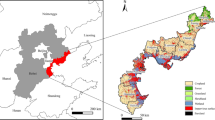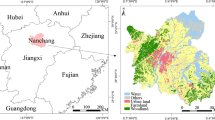Abstract
The stability of the wetland ecological network (WEN) is affected by the population gathering and rapid urbanization in metropolises. The identification of wetland ecological nodes and corridors is the basic condition of wetland ecological protection and restoration planning and project promotion. Taking Wuhan City as the research area, the purpose is to quantify the change characteristics of the WEN structure and simulate the stability of the WEN when it is disturbed and propose optimization strategies. Morphological Spatial Pattern Analysis (MSPA) and Circuit theory were used to construct the regional WEN from 1978 to 2018 and analyze its changing trend, and the evolution characteristics of the topological structure of the WEN were analyzed combined with the complex network theory. The results show that: (1) The number of wetland ecological sources showed an "n"-shaped change during the study period, and the wetland ecological source was gradually fragmented. The resistance surface of the study area showed an evolutionary trend of spreading from the central urban area to the surrounding areas, and the main factor causing resistance has gradually changed from cultivated land in the late twentieth century to construction land in the early twenty-first century; (2) The spatiotemporal changes of wetland ecological corridors were highly coupled with the spatiotemporal changes of wetland ecological sources; (3) The total number of ecological nodes gradually increased during the study period, and the largest increase was the high obstacle points. The ecological nodes spread rapidly from the city center to the surrounding areas during the study period, and the spread of high-importance nodes was the most significant; (4) The connectivity and resilience of WEN in the twenty-first century were significantly weaker than those in the late twentieth century, whether random or malicious, and the stability of WEN in the twenty-first century was getting weaker; (5) We propose a nodes restoration and protection strategy for WEN based on stability simulation and the comprehensive importance of nodes. From a spatial point of view, Tongshun River and Houguan Lake near Wuhan Economic and Technological Development Zone are the focus of WEN node restoration and protection, of which there are 2 key protection nodes (100%) and 10 key restoration nodes (83.33%). In general, this study provides a new perspectives for conservation and restoration planning of the wetland ecological environment, providing specific construction references for Wuhan's WEN planning.
摘要
大都市人口聚集和快速城市化影响到湿地生态网络的稳定性, 识别湿地生态节点和廊道, 为保护和修复湿地生态系统的规划和工程提供科学依据。本文以武汉市为例, 量化湿地生态网络结构,并探究其演变特征, 模拟湿地生态网络在受到干扰时的稳定程度。利用形态学空间格局分析(MSPA)和电路理论构建1978-2018年武汉湿地生态网络并分析其变化趋势, 结合复杂网络相关理论分析该湿地生态网络拓扑结构的演变特征。结果表明:(1)研究期内湿地生态源数量呈 “n”型变化, 湿地生态源逐渐碎片化; 研究区阻力面呈现出由中心城区向郊区扩散的演化趋势, 阻力的主要构成因素由20世纪末的耕地逐渐转变为21世纪初的建设用地; (2)湿地生态廊道与湿地生态源的时空变化具有高度耦合关系; (3)研究期内生态节点总数逐渐增加, 其中高障碍点增加最多。生态节点从城市中心向周边区域扩散速度较快, 其中高重要节点扩散最显著; (4)在两种破坏情景下, 与20世纪末相比, 21世纪初的湿地生态网络连通性和恢复力显著减弱; (5)结合网络稳定性模拟和节点综合重要性提出了湿地生态网络节点恢复和保护策略。 从空间上看, 武汉经济技术开发区附**的通顺河和后官湖是湿地生态网络节点恢复和保护的重点, 该地区关键保护节点有2个(100%), 关键恢复节点有10个(83.33%)。 综上所述, 本研究为湿地生态环境保护与恢复规划提供了新的视角, 为武汉市湿地生态环境规划提供了具体的建设参考。















Similar content being viewed by others
Data Availability
The datasets generated during and/or analysed during the current study are available from the corresponding author on reasonable request.
References
An Y, Liu S, Sun Y, Shi F, Beazley R (2021) Construction and optimization of an ecological network based on morphological spatial pattern analysis and circuit theory. Landscape Ecology 36(7):2059–2076. https://doi.org/10.1007/s10980-020-01027-3
Beatty WS, Kesler DC, Webb EB, Raedeke AH, Naylor LW, Humburg DD (2014) The role of protected area wetlands in waterfowl habitat conservation: Implications for protected area network design. Biological Conservation 176:144–152. https://doi.org/10.1016/j.biocon.2014.05.018
Bunn AG, Urban DL, Keitt TH (2000) Landscape connectivity: A conservation application of graph theory. Journal of Environmental Management 59(4):265–278. https://doi.org/10.1006/jema.2000.0373
Chen YY, Ke XL, Liu F, Min M (2019) Area, distribution and variation of wetland in wuhan for 4 periods since 1987. Wetland Science 17(05):553–558
Chen NN, Kang SZ, Zhao YH, Zhou YJ, Yan J, Lu YR (2021) Construction of ecological network in Qinling mountains of Shaanxi China based on Mspa and Mcr model. Chinese Journal of Applied Ecology 32(5):1545–1553. https://doi.org/10.13287/j.1001-9332.202105.012
Cluzel F, Yannou B, Millet D, Leroy Y (2016) Eco-Ideation and eco-selection of R&D projects portfolio in complex systems industries. Journal of Clean Production 112:4329–4343. https://doi.org/10.1016/j.jclepro.2015.08.002
Cong P, Chen K, Qu L, Han J, Yang Z (2020) Determination of landscape ecological network of Wetlands in the yellow river delta. Wetlands 40(6):2729–2739. https://doi.org/10.1007/s13157-020-01357-7
Cui B, Yang Q, Yang Z, Zhang K (2009) Evaluating the ecological performance of wetland restoration in the yellow river delta China. Ecological Engineering 35(7):1090–1103. https://doi.org/10.1016/j.ecoleng.2009.03.022
Dai C, Guo HC, Tan Q, Ren W (2016) Development of a constructed Wetland network for mitigating nonpoint source pollution through a Gis-based watershed-scale inexact optimization approach. Ecological Engineering 96:94–108. https://doi.org/10.1016/j.ecoleng.2015.06.013
De MA, Ganciu A, Cabras M, Bardi A, Peddio V, Caschili S, Massa P, Cocco C, Mulas M (2019) Resilient ecological networks: A comparative approach. Land Use Policy 89. https://doi.org/10.1016/j.landusepol.2019.104207
Dou P, Cui B (2014) Dynamics and integrity of Wetland network in Estuary. Ecological Informatics 24:1–10. https://doi.org/10.1016/j.ecoinf.2014.06.002
Dunne JA, Williams RJ, Martinez ND (2002) Network structure and biodiversity loss in food Webs: Robustness increases with connectance. Ecology Letters 5(4):558–567. https://doi.org/10.1046/j.1461-0248.2002.00354.x
Fan Y, Qiao Q, Fang L (2017) Network analysis of industrial metabolism in industrial park - A case study of Huai’an economic and technological development area. Journal of Cleaner Production 142:1552–1561. https://doi.org/10.1016/j.jclepro.2016.11.149
Fu Q, Song J, Mao F, Wu Y, Yao H, Tang J (2012) Evaluation and construction of Wetland ecological network in Qingdao city. Acta Ecologica Sinica 32(12):3670–3678
Fu L, Mo Z, Peng Y, **e M, Gao X (2019) Stability Identification and reconstruction strategy of ecological space network at the county scale: A case study of Chaling county hunan province. Acta Geographica Sinica 74(7):1409–1419
He J, Pan Y, Liu D (2020) Analysis of the Wetland ecological pattern in Wuhan city from the perspective of ecological network. Acta Ecologica Sinica 40(11):3590–3601
Herbert ER, Boon P, Burgin AJ, Neubauer SC, Franklin RB, Ardon M, Hopfensperger KN, Lamers LPM, Gell P (2015) A Global Perspective on Wetland salinization: Ecological consequences of a growing threat to freshwater wetlands. Ecosphere 6(10). https://doi.org/10.1890/ES14-00534.1
Huang XX, Wang HJ, Shan LY, **ao FT (2021) Constructing and optimizing urban ecological network in the context of rapid urbanization for improving landscape connectivity. Ecological Indicators 132. https://doi.org/10.1016/j.ecolind
Kuter S, Usul N, Kuter N (2011) Bandwidth determination for Kernel density analysis of wildfire events at forest sub-district scale. Ecological Modelling 222(17):3033–3040. https://doi.org/10.1016/j.ecolmodel.2011.06.006
Leonard PB, Duffy EB, Baldwin RF, McRae BH, Shah VB, Mohapatra TK (2017) Gflow: software for modelling circuit theory-based connectivity at any scale. Methods in Ecology and Evolution 8(4):519–526. https://doi.org/10.1111/2041-210X.12689
Li F, Zhang SW, Yang JC, Bu K, Wang Q, Tang JM, Chang LP (2016) The effects of population density changes on ecosystem services value: A case study in Western Jilin China. Ecological Indicators 61:328–337. https://doi.org/10.1016/j.ecolind.2015.09.033
Li YY, Zhang YZ, Jiang ZY, Guo CX, Zhao MY, Yang ZG, Guo MY, Wu BY, Chen QL (2021) Integrating morphological spatial pattern analysis and the minimal cumulative resistance model to optimize urban ecological networks: A case study in Shenzhen city China. Ecological Processes 10(1). https://doi.org/10.1186/s13717-021-00332-2
Liang J, He X, Zeng G, Zhong M, Gao X, Li X, Li X, Wu H, Feng C, **ng W, Fang Y, Mo D (2018) Integrating priority areas and ecological corridors into national network for conservation planning in China. Science of the Total Environment 626:22–29. https://doi.org/10.1016/j.scitotenv.2018.01.086
Lu J, Wang G, Ma J, Yu Q, Gao T, Niu T (2021) Forest ecological network construction and structure evaluation based on complex network theory in Bayi District of Tibet. Transactions of the Chinese Society for Agricultural Machinery 52(4):152–158
Luo Y, Wu J (2021) Linking the minimum spanning tree and edge betweenness to understand arterial corridors in an ecological network. Landscape Ecology 36(5):1549–1565. https://doi.org/10.1007/s10980-021-01201-1
McIntyre NE, Strauss RE (2013) A new multi-scaled graph visualization approach: An example within the playa wetland network of the great plains. Landscape Ecology 28(4):769–782. https://doi.org/10.1007/s10980-013-9862-4
Mehvar S, Filatova T, Syukri I, Dastgheib A, Ranasinghe R (2018) Develo** a framework to quantify potential sea level rise-driven environmental losses: A case study in Semarang coastal area Indonesia. Environmental Science & Policy 89:216–230. https://doi.org/10.1016/j.envsci.2018.06.019
Merrick MJ, Koprowski JL (2017) Circuit theory to estimate natal dispersal routes and functional landscape connectivity for an endangered small mammal. Landscape Ecology 32(6):1163–1179. https://doi.org/10.1007/s10980-017-0521-z
Miao Z, Pan L, Wang Q, Chen P, Yan C, Liu L (2019) Research on urban ecological network under the threat of road networks-a case study of Wuhan. Isprs International Journal of Geo-information 8(8). https://doi.org/10.3390/ijgi8080342
Mo W, Wang Y, Zhang Y, Zhuang D (2017) Impacts of road network expansion on landscape ecological risk in a megacity China: A case study of Bei**g. Science of the Total Environment 574:1000–1011. https://doi.org/10.1016/j.scitotenv.2016.09.048
Nie W, Shi Y, Siaw MJ, Yang F, Wu R, Wu X, Zheng X, Bao Z (2021) Constructing and optimizing ecological network at county and town scale: The case of Anji county China. Ecological Indicators 132. https://doi.org/10.1016/j.ecolind.2021.108294
Patten BC (2015) Link tracking: Quantifying network flows from qualitative node-link digraphs. Ecological Modelling 295:47–58. https://doi.org/10.1016/j.ecolmodel.2014.09.016
Pedersen E, Weisner SEB, Johansson M (2019) Wetland areas’ direct contributions to residents’ well-being entitle them to high cultural ecosystem values. Science of the Total Environment 646:1315–1326. https://doi.org/10.1016/j.scitotenv.2018.07.236
Peng J, Yang Y, Liu Y, Hu Y, Du Y, Meersmans J, Qiu S (2018) Linking ecosystem services and circuit theory to identify ecological security patterns. Science of the Total Environment 644:781–790. https://doi.org/10.1016/j.scitotenv.2018.06.292
Pierik ME, Dell’Acqua M, Confalonieri R, Bocchi S, Gomarasca S (2016) Designing ecological corridors in a fragmented landscape: A fuzzy approach to circuit connectivity analysis. Ecological Indicators 67:807–820. https://doi.org/10.1016/j.ecolind.2016.03.032
Reis V, Hermoso V, Hamilton SK, Ward D, Fluet-Chouinard E, Lehner B, Linke S (2017) A global assessment of inland wetland conservation status. Bioscience 67(6):523–533. https://doi.org/10.1093/biosci/bix045
Sheykhali S, Fernandez-Gracia J, Traveset A, Ziegler M, Voolstra CR, Duarte CM, Eguiluz VM (2020) Robustness to extinction and plasticity derived from mutualistic bipartite ecological networks. Scientific Reports 10(1). https://doi.org/10.1038/s41598-020-72922-7
Song S, Xu D, Hu S, Shi M (2021) Ecological network optimization in urban central district based on complex network theory: A case study with the urban central district of Harbin. International Journal of Environmental Research and Public Health 18(4). https://doi.org/10.3390/ijerph18041427
Tang F, Zhou X, Li W, Zhang Y, Fu M, Zhang P (2021) Linking ecosystem service and Mspa to construct landscape ecological network of the Huaiyang section of the grand canal. Land 10(9). https://doi.org/10.3390/land10090919
Turau V, Weyer C (2019) Cascading failures in complex networks caused by overload attacks. Journal of Heuristics 25:837–859. https://doi.org/10.1007/s10732-019-09413-0
Uwimana A, van Dam AA, Irvine K (2018) Effects of conversion of wetlands to rice and fish farming on water quality in valley bottoms of the migina catchment Southern Rwanda. Ecol Eng 125:76–86. https://doi.org/10.1016/j.ecoleng.2018.10.019
Verheijen BHF, Varner DM, Haukos DA (2018) Effects of large-scale wetland loss on network connectivity of the rainwater Basin Nebraska. Landscape Ecology 33(11):1939–1951. https://doi.org/10.1007/s10980-018-0721-1
Vogt P, Ferrari JR, Lookingbill TR, Gardner RH, Riitters KH, Ostapowicz K (2009) Map** functional connectivity. Ecological Indicators 9:64–71. https://doi.org/10.1016/j.ecolind.2008.01.011
Wang J, Jiang C, Qian J (2014) Robustness of interdependent networks with different link patterns against cascading failures. Physica A-Statistical Mechanics and Its Applications 393:535–541. https://doi.org/10.1016/j.physa.2013.08.031
Wang T, Li H, Huang Y (2021) The Complex Ecological network’s resilience of the Wuhan Metropolitan area. Ecological Indicators 130. https://doi.org/10.1016/j.ecolind.2021.108101
**a L, Zhang Y, Wu Q, Liu L (2017) Analysis of the Ecological relationships of urban Carbon metabolism based on the eight nodes spatial network model. Journal of Cleaner Production 140:1644–1651. https://doi.org/10.1016/j.jclepro.2016.09.175
**e Y, **e Y, **ao H (2019) Differential responses of litter decomposition to climate between wetland and upland ecosystems in China. Plant and Soil 440:1–9. https://doi.org/10.1007/s11104-019-04022-z
Xu HQ (2005) A study on information extraction of water body with the modified normalized difference water index (MNDWI). National Remote Sensing Bulletin 05:589–595
Xu W, Sun X, Zhu X, Zong Y, Li Y (2012) Recognition of important ecological nodes based on ecological networks analysis: A case study of urban district of Nan**g. Acta Ecologica Sinica 32(4):1264–1272
Yu Q, Yue D, Wang Y, Kai S, Fang M, Ma H, Zhang Q, Huang Y (2018) Optimization of ecological node layout and stability analysis of ecological network in Desert Oasis: A typical case study of ecological fragile zone located at Deng Kou County(Inner Mongolia). Ecological Indicators 84:304–318. https://doi.org/10.1016/j.ecolind.2017.09.002
Zeng Z, Peng H (2018) Remote sensing analysis of urban wetland loss and waterlogging a case of Wuhan South Lake. Resources and Environment in the Yangtze Basin 27(4):929–938
Zhang Y, Yang N (2013) Research on Robustness of R&D network under cascading propagation of risk with gray attack information. Reliability Engineering & System Safety 117:1–8. https://doi.org/10.1016/j.ress.2013.03.009
Zhang ZM, Wang XY, Zhang Y, Nan Z, Shen BG (2012) The over polluted water quality assessment of Weihe river based on kernel density estimation. Procedia Environmental Sciences 13:1271–1282. https://doi.org/10.1016/j.proenv.2012.01.120
Zhang X, Huang P, Sun L, Wang Z (2013) Spatial evolution and locational determinants of high-tech industries in Bei**g. Chinese Geographical Science 23:249–260. https://doi.org/10.1007/s11769-012-0581-6
Zhang ML, Qi YP, Zhang L, Chen Y, Zhou YP, Chen YH, Wang ST (2020) Identification and analysis of ecological nodes based on linkage mapper and granularity inverse method in the middle and Northern sections of Taihang mountain: A case study of Fu** county Hebei province. Journal of Ecology and Rural Environment 36(12):1569–1578. https://doi.org/10.19741/j.issn.1673-4831.2020.0417
Zhou D, Lin Z, Ma S, Qi J, Yan T (2021) Assessing an ecological security network for a rapid urbanization region in Eastern China. Land Degradation & Development 32:2642–2660. https://doi.org/10.1002/ldr.3932
Author information
Authors and Affiliations
Contributions
XYC conceived and designed the study, collected and analysed data, and drafted the initial stages of the manuscript, with input and guidance of HBL. HBL and TW commented on and provided revisions of the manuscript.
Corresponding author
Ethics declarations
Competing Interests
The authors have no relevant financial or non-financial interests to disclose.
Additional information
Publisher's Note
Springer Nature remains neutral with regard to jurisdictional claims in published maps and institutional affiliations.
Rights and permissions
Springer Nature or its licensor holds exclusive rights to this article under a publishing agreement with the author(s) or other rightsholder(s); author self-archiving of the accepted manuscript version of this article is solely governed by the terms of such publishing agreement and applicable law.
About this article
Cite this article
Cui, X., Li, H. & Wang, T. Structural Evolution and Stability Simulation of Wetland Ecological Network: A Case Study of Wuhan City, China. Wetlands 42, 73 (2022). https://doi.org/10.1007/s13157-022-01584-0
Received:
Accepted:
Published:
DOI: https://doi.org/10.1007/s13157-022-01584-0




